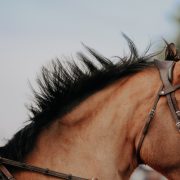No Hoof, No Horse: The Down Low on Thrush
Say the word “thrush” around any horse person, and they will wrinkle their nose in disgust. There is nothing less appealing than a mysterious, black, stinking fungus eating away at a horse’s hoof.
Heels Down Magazine interviewed Brett Williams, who has worked on horses’ hooves in Canada for more than three decades. After studying to be a farrier at Kwantlen Polytechnic University, he spent five years apprenticing under journeymen farriers Bob Schwar and Lou Grant – whom he will still call on occasion to ask for advice… Because after 30 years he still “sees things he’s never seen before.” From jumpers to Standardbreds, lesson horses and Thoroughbreds on the track, he’s worked on a variety of equines over the years.
Plus he’s based in the lower mainland of British Columbia, known for excruciatingly wet and muddy winter and spring seasons, which is arguably the thrush capital of the country.
Brett emphasizes that the responsibility of preventing thrush falls equally on owners and farriers. Proper hoof picking is an often a neglected task, as the prospect of picking up a muddy foot and holding it while a horse leans on you is not the most enjoyable of grooming chores. However, actually spending time thoroughly digging out the collateral grooves (the channels alongside the frog) is vital. It’s not enough to simply “get the big chunks out,” Brett explains.
Read this next: Our Favorite Barn Hacks
Most horse owners can give a rough estimate of a “good” shoeing job by looking at it from the outside, but not many are educated about foot health from the inside, Brett says. When a horse is shod, the natural wear of the sole is prevented. Trimming the sole and frog is just as important as the hoof wall. Over-trimming a frog, leaving substantial amounts of dead sole or under-trimming heels can aid the entry of bacteria that cause thrush. “Some farriers say that they don’t even touch a horse’s soles,” Brett said. “I give them a really hard time for that.”

The frog itself needs to be in contact with the ground, as the pressure stimulates blood flow, which in turn helps flush out any bacteria accumulation. If the frog is raised above the ground it can, in essence, “shrivel up”, thus providing home for bacteria, Brett described. This is where the phrase “horses have five hearts” comes from: lacking musculature in their lower legs, each of the four frogs acts as a “heart” to help pump blood back up the horse’s legs. The Frog plays a vital role in a horse’s overall health and soundness.
Like this article? Try: Why Is Strangles So Contagious In Horses?
For horses who are prone to thrush or living in very wet conditions, Brett recommends a small weekly application of KoperTox into the channels beside the frog. “People pour it all over the sole. You just need a tiny bit,” he says. Thrush Buster can also be used for treatment, but again in very small doses. In very extreme thrush cases, Brett will “burn out” a hoof using iodine crystals and turpentine.
The responsibility of preventing thrush falls equally on owners and farriers.
The iodine crystal treatment doesn’t necessarily need to be performed by a skilled farrier, but the product can be difficult to get ahold of, Brett says. Namely because it’s a main ingredient in crystal meth. Brett has an “in” at a local pharmacy, and the pharmacists trust him with the costly crystals, which he obtains only for his most severe thrush cases, he explains with a laugh.
When thrush progresses past the hoof and into the foot itself, the farrier and veterinarian need to work together to carve out diseased hoof and treat the bacteria beyond it. While often viewed as an annoying fungus, Brett said that he has seen horses with such bad thrush that they are “past the point of needing to be put down.” Preventative care is much easier than obtaining crystal meth ingredients, and he counsels owners to thoroughly clean stalls and paddocks, as well as the horses’ feet when they come in from the wet outdoors.

In terms of daily hoof care, Brett cautions that applying too much “product” to a horse’s hooves can do more harm than good. “Hoof polish is like ladies nail polish,” he says. “Too much makes their hooves dry and brittle.” He advises applying a bit of moisturizer at the coronet band, and massage it in. “People like to make their horses feet look all pretty and shiny. It doesn’t mean the hoof is healthy.”
The takeaway? Get cozy with the inside of your horse’s feet, because as Brett and many other wise horse people say, “No hoof, no horse.”


